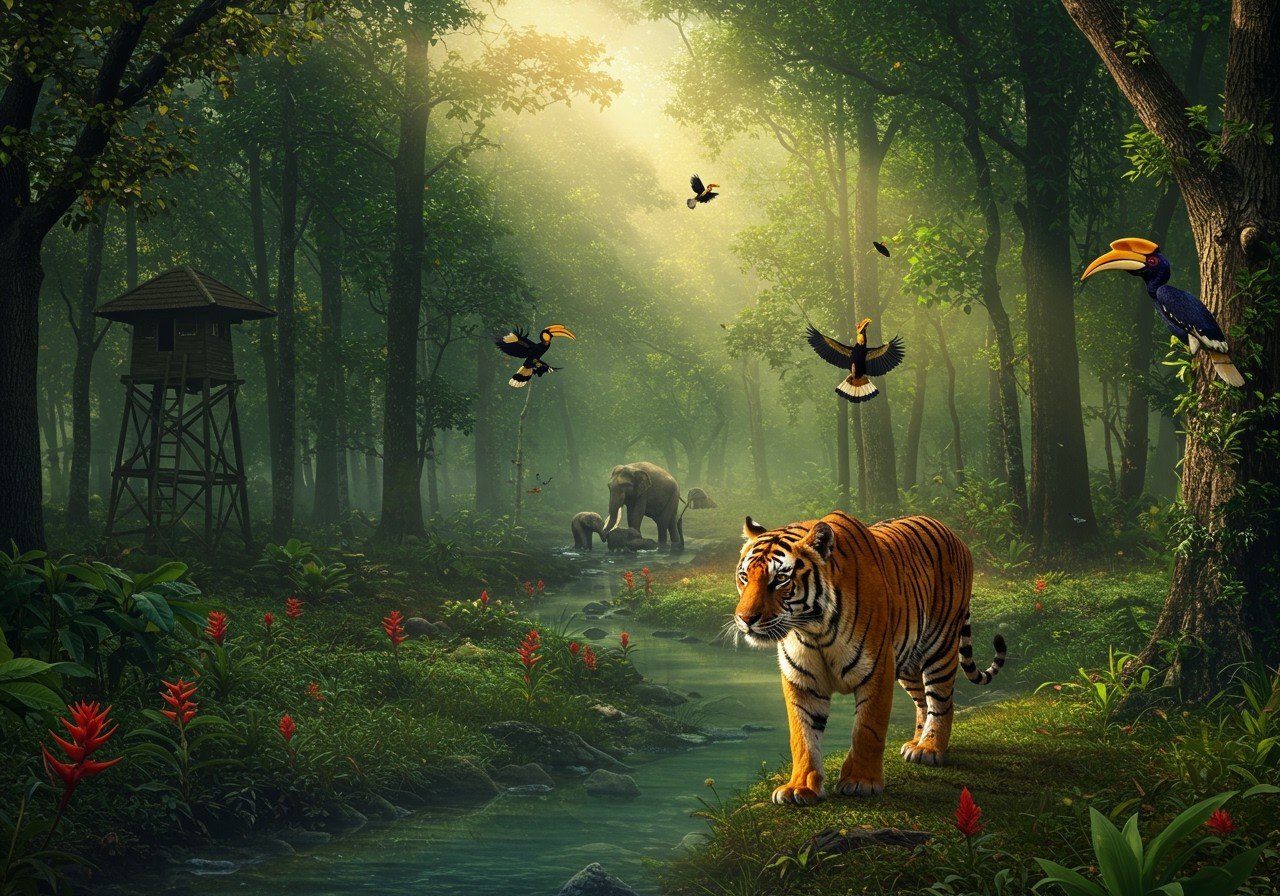
Kerala, a state in southwest India, is renowned for its breathtaking landscapes, diverse traditions, and rich wildlife. This blog invites you on a journey through Kerala’s remarkable sanctuaries and national parks, where you can discover unique ecosystems, learn about their cultural significance, and experience the thrill of encountering nature’s wonders.
Silent Valley National Park
Discover the Untamed Beauty of Silent Valley
Nestled in the Nilgiri Hills, Silent Valley National Park is a haven of pristine wilderness. This sanctuary is renowned for its exceptional biodiversity, including the rare Lion-tailed Macaque. In the 1970s, a proposed hydroelectric project threatened this natural treasure, but dedicated conservation efforts ensured its survival. Silent Valley is a testament to the power of collective action in preserving our planet’s precious ecosystems.
- History: Saved from a hydroelectric project in the 1970s, Silent Valley stands as a symbol of successful conservation. This victory underscores the importance of protecting natural habitats from human encroachment.
- Ecological Significance: Silent Valley boasts a rich tropical rainforest ecosystem with unique flora and fauna. This undisturbed environment provides crucial habitat for a wide range of species, contributing to the overall health of the Western Ghats.
- Topography: The park’s undulating hills and valleys create a stunning landscape. These varied terrains offer diverse microclimates and support a rich tapestry of plant and animal life.
- Conservation: Local communities play a vital role in preserving this natural heritage. Their active involvement ensures the long-term protection of Silent Valley’s unique biodiversity.
- Kunthi River: The Kunthi River flows through the heart of the park, adding to its scenic beauty and ecological significance. This river is a lifeline for the park’s diverse flora and fauna.
- Best Times to Visit: The ideal time to visit Silent Valley National Park is during the dry season, from December to April, when the weather is pleasant for trekking and wildlife viewing.
Eravikulam National Park
Explore the High-Altitude Wonders of Eravikulam
Eravikulam National Park, located in the Western Ghats, is characterized by high-altitude grasslands and shola forests. Established in 1978, the park serves as a crucial sanctuary for the endangered Nilgiri Tahr. Eravikulam showcases the unique montane ecosystems of the Western Ghats and offers a glimpse into the delicate balance of nature at high altitudes.
- Flora: Eravikulam is renowned for the rare Neelakurinji flower, which blooms only once every 12 years, transforming the landscape into a sea of blue. The next bloom is expected in 2030.
- Wildlife: In addition to the Nilgiri Tahr, the park is home to leopards, elephants, and a variety of bird species. Birdwatchers will delight in the diverse avian life found within the park’s varied habitats.
- Visitor Facilities: The Rajamala tourism zone offers panoramic views of the park’s stunning landscapes. This well-maintained area provides visitors with an accessible and enjoyable way to experience the park’s beauty.
- Sustainable Tourism: Eravikulam National Park prioritizes sustainable tourism practices to minimize environmental impact and preserve the park’s delicate ecosystem for future generations.
- Best Times to Visit: The best time to visit Eravikulam National Park is during the dry season, from December to April, when the weather is ideal for trekking and wildlife viewing.
Periyar National Park
Discover the Rich Biodiversity of Periyar
Periyar National Park, situated in the heart of the Western Ghats, is a biodiversity hotspot. Initially designated as a wildlife sanctuary in 1950, it later gained recognition as a tiger reserve. The park encompasses a diverse range of habitats, including evergreen forests, grasslands, and wetlands.
- Periyar Lake: The artificial Periyar Lake, created by the Mullaperiyar Dam, is a central feature of the park, providing a unique habitat for aquatic life and a scenic backdrop for wildlife viewing.
- Species: Periyar National Park is home to a thriving population of tigers, elephants, and a variety of bird species. It is a prime location for wildlife enthusiasts seeking to observe these magnificent creatures in their natural habitat.
- Conservation: The park implements robust anti-poaching measures and community-based ecotourism programs to protect its valuable wildlife and engage local communities in conservation efforts.
- Activities: Visitors can enjoy a range of activities, including boat safaris, nature walks, and bamboo rafting, providing immersive experiences in the heart of nature.
Anamudi Shola National Park
Explore the Heights of Anamudi Shola
Anamudi Shola National Park encompasses Anamudi peak, the highest peak in peninsular India. This park is part of a larger network of protected areas, contributing to the region’s rich biodiversity. The park’s unique location and diverse habitats make it a valuable asset in preserving the ecological integrity of the Western Ghats.
- Highest Peak: Anamudi peak, standing tall within the park, offers breathtaking views and a challenging climb for experienced trekkers.
- Surrounding Parks: Its proximity to other sanctuaries enhances its ecological value, creating a vital corridor for wildlife movement and gene flow.
- Flora and Fauna: A wide array of plant and animal species thrive in this protected area, contributing to the overall biodiversity of the Western Ghats.
- Visitor Experience: Anamudi Shola National Park offers a unique blend of adventure and tranquility, appealing to both thrill-seekers and nature lovers.
Chinnar Wildlife Sanctuary
Experience the Rainy Season Charm of Chinnar
Chinnar Wildlife Sanctuary, located near Munnar, is known for its unique rainy season and offers comfortable accommodations for visitors. This sanctuary is a haven for wildlife enthusiasts seeking a more immersive experience in nature.
- Climate: Chinnar Wildlife Sanctuary is characterized by its distinctive rainy season, which transforms the landscape into a lush green paradise.
- Accommodation: Visitor-friendly lodgings are available within the sanctuary, allowing guests to fully immerse themselves in the natural surroundings.
- Wildlife: The sanctuary boasts a rich diversity of species, providing ample opportunities for wildlife spotting and photography.
Embrace the Wild Heart of Kerala
Kerala’s wildlife sanctuaries and national parks are true gems waiting to be discovered. Each park offers a unique glimpse into the region’s biodiversity and cultural heritage. The active involvement of local communities in conservation underscores the deep connection between people and nature in this remarkable part of the world. Whether you’re trekking through Silent Valley, witnessing the rare bloom in Eravikulam, or exploring Periyar’s vast landscapes, Kerala promises an unforgettable wildlife adventure.
Enhance Your Kerala Wildlife Experience with Natural Products from Poojn.in
Planning a trip to Kerala’s wildlife sanctuaries? Poojn.in, India’s leading online store for cultural and spiritual products, offers a range of natural products that can enhance your journey:
- Sandalwood: Known for its calming and insect-repelling properties, sandalwood is a must-have for any wildlife adventure. Poojn.in offers 100% pure sandalwood products.
- Incense Sticks: Create a serene atmosphere during your nature retreat with natural incense sticks from Poojn.in. Choose from a variety of fragrances to enhance your relaxation.
- Tulsi Mala: Embrace the spiritual side of nature with a Tulsi mala from Poojn.in. This sacred bead is believed to bring peace and positive energy.
Visit Poojn.in today to discover a wide selection of natural products that can complement your Kerala wildlife experience.
FAQs: Your Kerala Wildlife Guide
What’s the ideal time to explore Silent Valley? The dry season, from December to April, offers the most pleasant weather for trekking and wildlife viewing in Silent Valley National Park.
Which animals can I spot in Eravikulam? Eravikulam National Park is home to the endangered Nilgiri Tahr, elephants, leopards, and diverse bird species. You might even witness the rare blooming of the Neelakurinji flower, which occurs once every 12 years.
How can I get to Periyar National Park? Periyar National Park is easily accessible by road. The nearest town, Thekkady, is well-connected to major cities like Kochi and Madurai via bus and taxi services.
Are there accommodations inside Silent Valley National Park? While there are no accommodations within the park itself, you can find various lodging options in nearby towns like Mukkali.
What can I do in Eravikulam National Park? Enjoy trekking, wildlife spotting, birdwatching, and guided tours to learn about the park’s unique flora and fauna.
Is boating available in Periyar National Park? Yes, boating on Periyar Lake is a popular activity, offering scenic views and opportunities for wildlife sightings.
Do I need a guide in Silent Valley? Hiring a guide is mandatory in Silent Valley National Park for safety and informational purposes.
How much is the entry fee for Eravikulam? Entry fees vary for Indian and foreign nationals. It’s best to check the official website for the most up-to-date pricing information.


